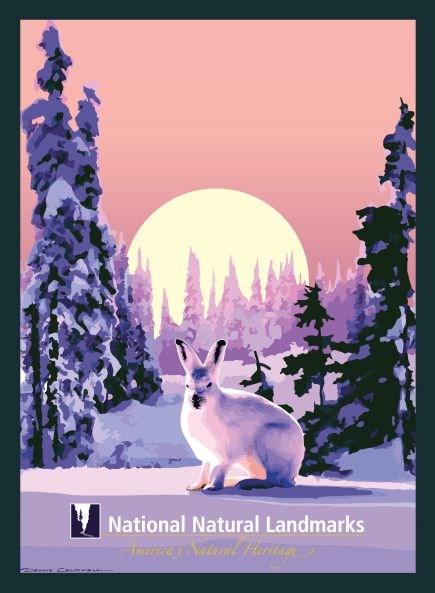
The animals and plants that call boreal forests home are adapted for long, frigid winters, short dry summers, and frequent fires. Boreal forests have only a thin top layer of unfrozen soil, so plant inhabitants like spruce and other conifer trees typically have shallow root systems. The slender and conical shape of these trees allows for snow to shed off, and their waxy needles are drought- and frost-resistant. Animals like moose and caribou rely on splayed hooves and long legs to help them traverse the deep snow. Others–such as the snowshoe hare, ptarmigan, and stoat–have coats that change color to better blend in with contrasting summer and winter environments.
In the United States, boreal forests occur primarily in Alaska and in northern states along the Canadian border, but this biome also exists in pockets of high elevation as far south as North Carolina.
There are National Natural Landmarks designated for their boreal ecosystems nationwide that illustrate the beauty and diversity of these ecosystems. Some of these include:
- Gulf Hagas, ME
- Mount Katahdin, ME
- No. 5 Bog and Jack Pine Stand, ME
- Cedar Creek Natural History Area-Allison Savanna, MN
- Keeley Creek Natural Area, MN
- Lac La Croix Research Natural Area, MN
- Lake Agassiz Peatlands Natural Area, MN
- Pine Point Research Natural Area, MN
- Upper Red Lake Peatland, MN
- East Inlet Natural Area, NH
- Long Hope Creek Spruce Bog, NC
- Mount Mitchell State Park, NC
- Buzzardroost Rock-Lynx Prairie-The Wilderness, OH
- White Pine Bog Forest, OH
- Camel's Hump, VT
- Mount Mansfield Natural Area, VT
- Bear Rocks and Allegheny Front Preserve, WV
- Canaan Valley, WV
- Ice Mountain, WV
- Gaudineer Scenic Area, WV
- Shavers Mountain Spruce-Hemlock Stand, WV
- Ridges Sanctuary-Toft's Point-Mud Lake Area, WI
- Spruce Lake Bog, WI
- Summerton Bog, WI
Last updated: April 10, 2025
